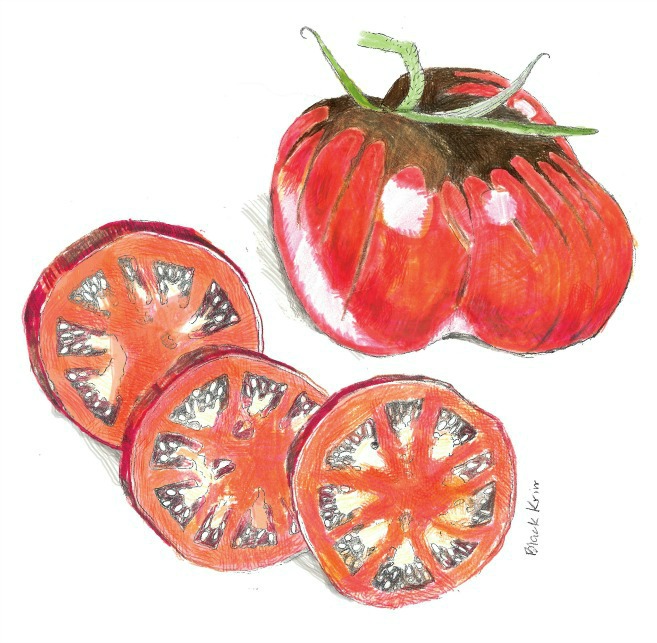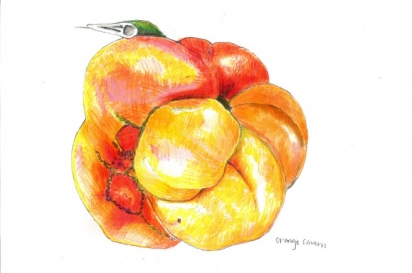Heirlooms: Or Why Everything Has Its Season
The tomatoes of my youth were red tomatoes, summer tomatoes. My grandmother grew them against the sun-baked wall of their garage. She didn’t talk names, just health and vigor, paper sacks of them pressed into our hands when we were leaving. A July dinner table growing up inevitably included a soup bowl of peeled, peppered cucumbers in cider vinegar and ice, a platter of cantaloupe wedges, and homegrown sliced tomatoes, oozy and bleeding across the plate.
Here, some history I should share.
One: I did not willingly eat a raw, unadulterated tomato until after I graduated college. Raw tomatoes were first on a list of maybe two or three things I hated, the second being mayonnaise.
Two: My father ate tomatoes with mayonnaise and a little salt and pepper, sliced and cut into wedges like pie. I still feel a little queasy when I think about it. There was one night, in order to be allowed to do something all by myself with my father (in other words, a modern miracle), I had to eat a slice of raw tomato, and I almost didn’t make it.
Three: I had a crush on a boy my junior year who drove a Jeep without a top and was entirely devoted to his girlfriend from another school. Still, we hung out a lot— a painful, swoony form of masochism. Once, at the mall, I extracted the red web of a tomato slice from the heart of my club sandwich, and he said, “I try to avoid foods in the larval stage.” Larval. He was brilliant.
It’s hard to say what changed. Our palates continue to develop as long as we’re alive. I never dated the boy with the Jeep and the pinpoint gastronomic observations. But I moved away, got married, learned to cook, planted a garden of my own in loamy Pennsylvania soil that put forth tomatoes from July through September big as fists, yellow and orange and deep bursting red. Because what were you supposed to put in a garden but tomatoes? My favorite was Brandywine. And the meal that mattered was a BLT.
There is nothing to compare to two pieces of sourdough toast, lightly smeared with mayonnaise, a leaf of lettuce, three strips of bacon, and a slice from the center of a tomato you grew yourself. Juice and bread, salt and fat, eaten sweaty and leaning over the sink in the kitchen, it is the sandwich-soul of summer.
I understand now that Brandywine is a strain of pink beefsteak tomato that first appeared in seed catalogs in the late 19th century, renown since for its meaty, balanced tomato flavor: as sweet as it is sharp. It’s considered an heirloom, in that it’s a variety that’s spent more than 50 years in circulation. Some heirlooms are seeds saved and passed down through families; some are mystery products of open pollination, but all of them reproduce true to their roots.
The names of heirloom tomatoes are particularly lush: Mullen’s Mortgage Lifter, Jaune Flamme, Oxheart, Russian Black, Green Zebra, Red Rose, Cherokee Purple, German Pink. They have shoulders and hips, stripes and cracks. Some taste crisp and citrusy; some like smoke, some like grass.
Even these old tomatoes are still nature’s hybrids. The original tomato is nothing we would recognize: tiny pea-sized fruits growing on shrubs in the high deserts of Peru, passed through Mesoamerica into Spanish hands, onward to the rest of the globe. How they became the cultivated tomato we know today is a path still being traced.
But there’s maybe even less of a connection between heirloom tomatoes and the round, red baseballs we buy year-round in the grocery store. Begin with the fact that roughly 90% of fresh out-of-season tomatoes in this country are grown in Florida, where the climate might be warm, but too humid, and the soil too poor, for a plant to survive without massive amounts of chemical support. Add the fact that growers are governed by the Florida Tasting Committee, which dictates the blemish-free, smooth shape and size of every tomato exported, and that tomatoes will be harvested “mature green,” gassed with ethanol to a palatable color, but still hard enough to ship anywhere without bruising. Even in their unripe state, tomatoes are hand picked by the piece, meaning migrant workers are paid a set amount per container rather than steady, liveable wage. In his eye-opening book Tomatoland, Barry Estabrook describes the sad state of tomato farming slow to change:
In this world, slavery is tolerated, or at best ignored. Labor protections for workers predate the Great Depression. Child labor and minimum wage laws are flouted. Basic antitrust measures do not apply. The most minimal housing standards are not enforced. Spanish is the lingua franca...Pesticides, so toxic to humans and so bad for the environment that they are banned outright for most crops, are routinely sprayed on virtually every Florida tomato field, and in too many cases, sprayed directly on workers.
Apparently, to the tune of five billion dollars annually, untold human and environmental cost, we will buy anything that looks like a tomato. Taste has never been part of the conversation. And it’s not that we’re happy enough with what get; according to Estabrook, study after study ranks commercially-grown tomatoes at the bottom of the list in terms of customer satisfaction in the grocery store.
There are folks at work on this in Florida, the folks who brought you UglyRipe tomatoes and the smaller Tasti-Lee, two brand-name varieties trying to break out of the Florida Tomato Commission box. A recent paper published in the journal Science claims part of the culprit might be color itself: the gene that allows a tomato ripen uniformly red might also rob it of some compounds that give it flavor.
In the way that everything comes full circle, I find myself returning to that plate of sliced tomatoes at my family’s summer table. Everyone must have an image like this one, of ripe red plenty, a tomato ideal they call to mind when faced with what’s available in the produce section. We want the tomato in our hand to match the one in our memory: the snap of the skin, the fresh-cut, dripping flavor, sweet and tart. It has to be a testament to the greatness of a summer tomato that we keep hoping for a semblance of it in December.
And so an heirloom tomato might just be the antidote to all of this, the opposite of nostalgia, the imperfect perfection. In all its lumpy, bumpy glory, the essence of enjoying what we have when we have it, over when the season ends.







